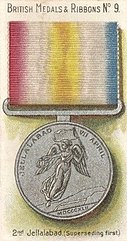
The Turkish Crimean War Medal is a campaign medal issued by Sultan Abdülmecid I of the Ottoman Empire to allied military personnel involved in the Crimean War of 1854–56. It was only awarded to those who survived the war and not to next of kin. There are three different issues of this medal for British, French, or Sardinian personnel. The medal was designed by James Robertson.
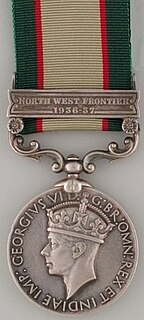
The Indian General Service Medal was a campaign medal approved on 3 August 1938, for issue to officers and men of the British and Indian armies, and of the Royal Air Force.

The Crimea Medal was a campaign medal approved on 15 December 1854, for issue to officers and men of British units which fought in the Crimean War of 1854–56 against Russia. The medal was awarded with the British version of the Turkish Crimea Medal, but when a consignment of these were lost at sea, some troops were received the Sardinian version.
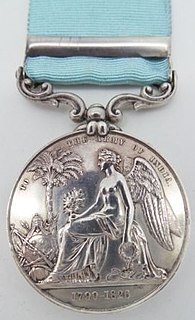
The Army of India Medal (AIM) was a campaign medal approved in 1851 for issue to officers and men of the British Army and the Army of the Honourable East India Company. A retrospective award following the precedent set by the Naval General Service Medal and the Military General Service Medal, it served to reward service in various actions from 1803 to 1826.
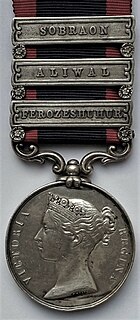
The Sutlej Medal was a campaign medal approved in 1846, for issue to officers and men of the British Army and Honourable East India Company who served in the Sutlej campaign of 1845-46. This medal was the first to use clasps to denote soldiers who fought in the major battles of the campaign.

The Victory Medal is a United Kingdom and British Empire First World War campaign medal.

The India Medal was a campaign medal approved in 1896 for issue to officers and men of the British and Indian armies.
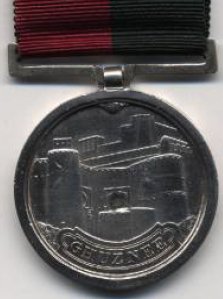
The Ghuznee Medal is a British campaign medal awarded for participation in the storming of the fortress of Ghuznee in Afghanistan, on 21 to 23 July 1839 by troops of the British and Indian Armies. This action, the Battle of Ghazni, took place during the First Anglo-Afghan War.

The Afghanistan Medal, sanctioned on 19 March 1881, was awarded to members of the British and Indian armies who served in Afghanistan between 1878–1880 during the Second Afghan War, the first war being from 1839–1842.

The New Zealand War Medal was a campaign medal authorised in 1869 to be awarded to Imperial and Colonial troops involved in the New Zealand Wars of 1845–47 and 1860–66. The New Zealand Wars were previously known as the Māori Wars, Anglo-Māori Wars or Land Wars.
The Army Gold Medal (1808–1814), also known as the Peninsular Gold Medal, with an accompanying Gold Cross, was a British campaign medal awarded in recognition of field and general officers' successful commands in campaigns, predominantly the Peninsular War. It was not a general medal, since it was issued only to officers whose status was no less than that of battalion commander or equivalent.
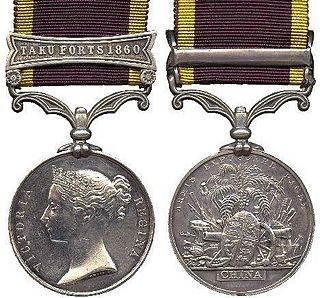
The Second China War Medal was issued by the British Government in 1861 to members of the British and Indian armies and Royal Navy who took part in the Second Opium War of 1857 to 1860 against China. The medal was designed by William Wyon.

The China War Medal was issued by the British Government in 1843 to members of the British and Indian forces who took part in the First Anglo-Chinese War (1839–42). The medal was designed by William Wyon.
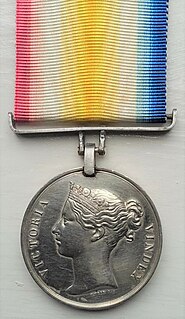
The Candahar, Ghuznee, Cabul Medal was awarded to those who took part in the campaign in the spring and summer of 1842, under the command of General William Nott, to restore British standing in Afghanistan after earlier defeats during the First Anglo-Afghan War.
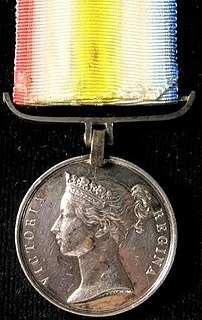
The Scinde Medal was authorised on 22 September 1843 and issued to soldiers of the Honourable East India Company, the 22nd Regiment of Foot of the British Army and members of the Indian Navy who manned the Indus Flotilla, who participated in Major General Sir Charles Napier's conquest of Scinde between 1842 and 1843.

The Kabul to Kandahar Star, also known as the Roberts Star or Kandahar Bronze Star was awarded to those British and Indian troops who participated in the 320 mile march from Kabul to Kandahar in Afghanistan between 9–31 August 1880, under the command of General Frederick Roberts. In addition, it was awarded to the troops stationed en route at Kelat-i-Ghilzie, who accompanied General Roberts on the final ninety miles to Kandahar.

The Gwalior Star is a Campaign medal presented by the Honourable East India Company to the soldiers of the British Army and the British led Bengal Army who took part in the 1843 Gwalior Campaign.

The Kelat-I-Ghilzie Medal is a campaign medal issued by the British East India Company, to the defenders of the fort at Kelat-I-Ghilzie during the First Anglo-Afghan War.
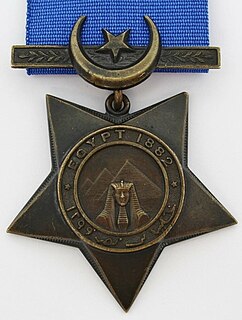
The Khedive's Star was a campaign medal established by Khedive Tewfik Pasha to reward those who had participated in the military campaigns in Egypt and the Sudan between 1882 and 1891. This included British forces who served during the 1882 Anglo-Egyptian War and the subsequent Mahdist War, who received both the British Egypt Medal and the Khedive's Star. Cast in bronze and lacquered, it is also known as the Khedive's Bronze Star.
The following is the list of orders, decorations and medals of British India:

